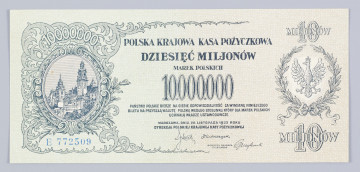
Cheque for 50,000,000 Polish marks - a template
1923
National Museum in Lublin
Part of the collection: Paper money during the Second Polish Republic
The inflation that had been building up in Poland since the beginning of 1919 was accompanied by an increase in state spending over income. This resulted in a growing budget deficit that could not be balanced by the ruined economy of the young state. Efforts to obtain a foreign loan for this purpose also failed. It was decided that an ad hoc solution would be found, namely the elimination of the deficit through the printing of banknotes. However, before it could happen, it was necessary to design a new issue, as the previous one - from the first half of 1919 by Adam Półtawski - proved easy to counterfeit. The commission was accepted by the Vienna State Printing House, which produced a characteristic design in the style of the Vienna Secession. Some banknotes were printed in private Warsaw workshops.
These banknotes were divided into two series: the first one of 1, 2, 5, 10, 20, 100, 500 and 1000 mkp, dated 28 August 1919, and the next one of ½ and 5000 mkp, dated 7 February 1920. Their issuer was the Polish National Loan Bank (PKKP). The post-war economic crisis caused a decline in the value of paper money, issued without any cover and no longer convertible to gold and silver coins. From July 1919 to the end of March 1920, the nominal value of mkp put into circulation increased six-fold. At the same time, the price of the dollar in this currency increased nine times.
The heroes of these banknotes are Queen Jadwiga (1384-1399) and Tadeusz Kościuszko (1746-1817). The female figure was probably intended to personify Polonia, which the Viennese artist used a depiction of Queen Jadwiga by Jan Matejko to illustrate. Tadeusz Kościuszko, in turn, was the desired type of hero uniting all social groups in the fight for independence. Promoting attitudes of social solidarity and patriotic generosity was very much needed during the Polish nation's struggle to maintain its statehood.
The 5 mkp banknote was printed in green and brown, with various shades of colour, in typographic technique on smooth white paper. It was in circulation from 5 December 1919 to 1 July 1924, when the zloty issued by the Bank of Poland became the sole legal tender and for the first time in history composed of 100 groszy.
At the beginning of December 1919, a camera made by Emil Busch was offered in Warsaw for 530 mkp, and for the sum of 8.5 mkp – a pood (16.38 kg) of firewood.
Tomasz Markiewicz
Author / creator
Dimensions
cały obiekt: height: 133 mm, width: 81 mm
Object type
paper money
Technique
Material
paper
Creation time / dating
Creation / finding place
Owner
The National Museum in Lublin
Identification number
Location / status

1923
National Museum in Lublin

1923
National Museum in Lublin

1923
National Museum in Lublin
DISCOVER this TOPIC
National Museum in Szczecin
DISCOVER this PATH
Educational path